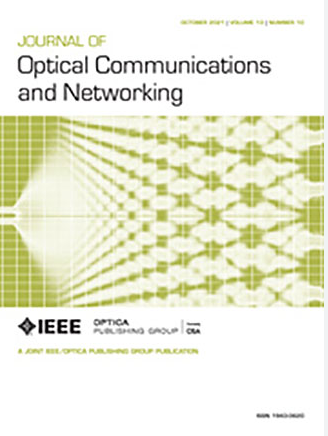Optimizing satellite and core networks for a global quantum network
IF 4
2区 计算机科学
Q1 COMPUTER SCIENCE, HARDWARE & ARCHITECTURE
引用次数: 0
Abstract
Quantum key distribution (QKD) promises information theoretic security. However, the exponential decay of the secure key in optical fibers leads to limitations in long distance QKD distribution across fibers, which is necessary for global quantum networks (QNs). Satellite QKD can be used to generate keys over long distances bypassing fiber limitations and is thus a promising approach for global QNs. In this paper, we construct mixed integer linear program (MILP) models to investigate how to best connect the core fiber network to ground stations to minimize the overall network cost. We design one MILP that can provide a quantitative value for the number of satellites needed for a given configuration and another one to optimize the allocation of the core network nodes to ground stations to minimize the overall network cost. We use these models to investigate different strategies to allocate satellites to ground stations during a satellite overpass, showing that allocating satellites based on the expected transmission requirements can reduce the number of satellites needed in a network by up to 40% compared to randomly allocating the satellites to ground stations. Furthermore, we use these models to investigate securing the data center traffic in two networks, one local European network and one global network, and show that costs in the optimal configuration can be up to 40% cheaper than simply connecting core network sites to their geographically closest ground station.为全球量子网络优化卫星和核心网络
量子密钥分发(QKD)具有信息理论上的安全性。然而,安全密钥在光纤中的指数衰减导致了跨光纤长距离 QKD 分布的局限性,而这正是全球量子网络(QN)所必需的。卫星 QKD 可以绕过光纤限制,远距离生成密钥,因此是全球量子网络的一种有前途的方法。在本文中,我们构建了混合整数线性程序(MILP)模型,研究如何以最佳方式将核心光纤网络与地面站连接起来,从而最大限度地降低整体网络成本。我们设计了一个 MILP 模型,可以为给定配置所需的卫星数量提供一个定量值;另一个 MILP 模型可以优化核心网络节点与地面站的分配,从而最大限度地降低整体网络成本。我们利用这些模型研究了在卫星超限期间向地面站分配卫星的不同策略,结果表明,与随机向地面站分配卫星相比,根据预期传输要求分配卫星可将网络所需卫星数量最多减少 40%。此外,我们还利用这些模型研究了两个网络(一个是欧洲本地网络,另一个是全球网络)中数据中心流量的安全问题,结果表明,与简单地将核心网络站点连接到地理位置上最近的地面站相比,最优配置的成本最多可降低 40%。
本文章由计算机程序翻译,如有差异,请以英文原文为准。
求助全文
约1分钟内获得全文
求助全文
来源期刊
CiteScore
9.40
自引率
16.00%
发文量
104
审稿时长
4 months
期刊介绍:
The scope of the Journal includes advances in the state-of-the-art of optical networking science, technology, and engineering. Both theoretical contributions (including new techniques, concepts, analyses, and economic studies) and practical contributions (including optical networking experiments, prototypes, and new applications) are encouraged. Subareas of interest include the architecture and design of optical networks, optical network survivability and security, software-defined optical networking, elastic optical networks, data and control plane advances, network management related innovation, and optical access networks. Enabling technologies and their applications are suitable topics only if the results are shown to directly impact optical networking beyond simple point-to-point networks.

 求助内容:
求助内容: 应助结果提醒方式:
应助结果提醒方式:


